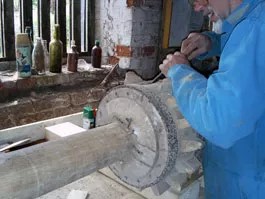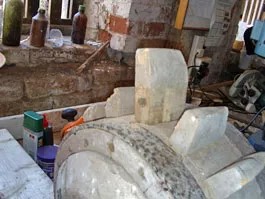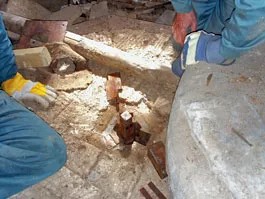Best viewed in landscape
Watermill Blog - Moving Machinery
1st May 2008
This watermill blog is happy to report that the 1st of May was mild and sunny and the perfect day for getting on with the job of bringing the old watermill back to life.
Colin, John, Dick and Richard were on site at the usual time while Martyn was working off site. Jonathan joined us only a little later.
Colin and Richard made a few checks of the hurst and then used a large pry-bar to move the cross beam that carries the centre post back into its original position. This re-engaged the wallower gear at the bottom of the centre shaft with the pit-gear, reconnecting the machinery to the waterwheel.
A few more checks, and making sure that John and Jonathan were well clear of the gear pit and we were ready to see if everything would turn. Colin pedalled the waterwheel round gently while Richard captured the moment on video. This is the first time the waterheel has turned machinery inside the mill for at least 40 years and probably much longer.
The temptation was to keep playing but John and Jonathan wanted to put the finishing touches to the walls of the gear pit so we chained the wheel back up for safety and let them get on with the bricklaying.

With work on the chaff cutter almost complete except for the straw conveyor, Dick turned his attention to the sack hoist pinion that engages with the crown wheel on the centre shaft.
Like all the other wooden gear teeth made of fruit wood these have been a woodworm banquet for years and will all need to be replaced.
The pinion carries sixteen woodedn teeth, each one a tight fit in a socket in the boss. They are secured with thin dowels driven through the boss and time and decay have made these very difficult to remove.

The first tooth to come out did so in hundreds of little pieces and took about an hour do extract. We had to find a better way. Richard joined Dick and together they tackled one of the soundest teeth.
They managed to drive the dowel out and then loosened the tooth with mallet blows. Some careful prising with a chisel and out it popped. At least we now have a pattern to make the replacements.
Dick came up with the idea of making a crude puller to draw the more rotten teeth. The idea worked well and by close of play we hade extracted nearly a third of the teeth.
Martyn arrived at lunchtime, complete with a section of the PTO shaft that has had one of the journals built up and re-finished. It had proved to be at the limit of what the machine shop could handle but is much better than it was. Four of us walked it round to the workshop in "easy" stages.

Before Martyn arrived, Colin had slung the runner stone of the upstream pair aside so that he and Martyn could look at how to go about setting the spindle bearing in the bedstone.
The bearing consists of three wooden segmants adjusted with steel edges. Lubrication is done with tallow soaked horsehair between the segments. It seems it bit crude to our modern eyes but it worked well for many years without problems so it must be OK.
It was a very satisfying day all round, greatly helped by the weather that stayed dry all day. Progress is likely to be a bit slower for the next few weeks as a number of volunteers, including the webmaster, take holiday breaks.
Go to the next Watermill Blog Entry
Go to the previous Watermill Blog entry
Learn how to Support Us
Return to our Home Page